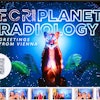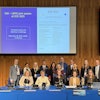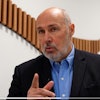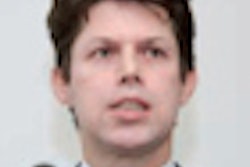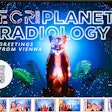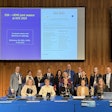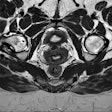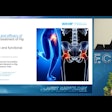
VIENNA - Brazilians have a thirst for knowledge-sharing, and the country offers numerous investment opportunities, but it needs substantial reforms in healthcare and education to diminish social inequalities and address public health concerns, European Congress of Radiology (ECR) delegates learned at Saturday's European Society of Radiology (ESR) Meets Session.
Brazil has a population around 185 million inhabitants, making it the world's fifth most populated country, according to Dr. Manoel Aparecido Gomes da Silva, resident of the Brazilian College of Radiology and Diagnostic Imaging (CBR). It is also the fifth largest nation in the world in terms of land mass and the ninth largest global economy, with a gross domestic product of $2 trillion. Gross domestic product (GDP) per capita is around $10,800.
The country will host the football World Cup in 2014, and the Summer Olympic Games in 2016, so it is certain to face increasing media scrutiny over the next few years.
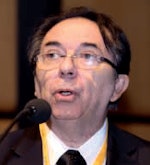 Manoel Aparecido Gomes da Silva from São Paulo. All images courtesy of the European Society of Radiology.
Manoel Aparecido Gomes da Silva from São Paulo. All images courtesy of the European Society of Radiology.
As a multiracial society, Brazil is in a unique position to enable professionals to build their careers, believes Gomes da Silva, who moderated Saturday's session, together with Dr. Yves Menu, president of ECR 2011. He is convinced Brazilian radiologists are keen to build cooperation in many areas, and the CBR has an important role to play in this process. It is responsible for the professional defense of its members, plus their qualifications and the spread of scientific information. It publishes its own journal: Radiologia Brasileira.
Tuberculosis (TB) represents one of Brazil's major public healthcare problems, as outlined by Dr. Arthur Soares Souza Jr., from Ultra X: diagnóstico por Imagem, Medical School of São José do Rio Preto. He explained that 22 countries account for 80% of those infected with TB worldwide, and Brazil occupies the 19th spot with 70,000 new cases per year and 4,735 annual deaths. It has a cure rate of 77%, compared with the World Health Organization's 2007 recommendation of 85%. The percentage of cases involving multidrug-resistant TB in Brazil is 0.9%, compared with the global average of 4.9%. There have been three cases of extremely resistant TB reported in Brazil.
 Dr. Arthur Soares Souza Jr. from São José do Rio Preto.
Dr. Arthur Soares Souza Jr. from São José do Rio Preto.
The main risk factors for TB are poverty, low urban development, the dismantling of healthcare systems, and HIV, explained Souza. Mycobacterium TB is the causative agent, and transmission is via inhalation of droplets. In tissue, it involves the formation of granuloma with caseous necrosis. It is often accompanied by malnutrition, alcohol or drug abuse, immunosuppressive therapies, and a coexisting disease such as diabetes and silicosis. Co-infection of HIV and TB is increasingly an issue.
Congenital lung disease in children is another important topic in Brazil. Malformations include a heterogeneous group of anomalies affecting the lung parenchyma, the arterial supply to the lung and its venous drainage, and they appear in an isolated or combined form, according to Dr. Pedro Daltro, from Clínica de Diagnóstico por Imagem and Instituto Fernandes Figueira -- FIOCRUZ in Rio de Janeiro. They can range from small and asymptomatic entities to large space-occupying masses that require immediate surgical treatment, and hybrid conditions are often seen.
Imaging has an essential role before and after birth, but it requires a comprehensive understanding of the findings. He advises radiologists to carefully analyze and describe airway, lung, mediastinal, and vascular components. Prenatal ultrasound and MRI are contributing to a better understanding of this field, allow more objective counselling, and more efficient treatment during the postnatal period, leading him to state that the future is promising.
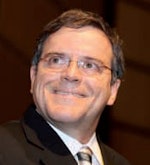 Dr. Pedro Daltro from Rio de Janeiro.
Dr. Pedro Daltro from Rio de Janeiro.
In congenital lung lesions, the majority of masses are detected as an incidental finding in ultrasound during the second and third trimesters. Better understanding of natural history and clinical outcomes, as well as improvements in prenatal diagnostic parental counseling and pregnancy management decisions, are of value here. The prenatal diagnosis of congenital thoracic lesions can be critical for the prognosis of the fetus. Fetal chest abnormalities can be evaluated with ultrasound, but MRI is an important adjunct technique for the assessment of these pathologies, Daltro stresses.
An MR examination may be necessary for a fetal lung mass to confirm a finding or provide additional details, to clarify equivocal sonographic diagnosis, to evaluate the impact on pregnancy management counseling, and optimize postnatal imaging algorithm.
Chest radiography can detect many congenital lung lesions, but CT may be useful to confirm the presence of the lesion, to determine the extent of the lesion, and to define associated abnormalities, he explained. Reconstructed data from CT examinations displayed in either 3D or multiplanar formats can be particularly helpful in delineating abnormalities of the bronchi, along with CT angiography (CTA) for arterial and venous structures. Minimizing the radiation dose is compulsory, he warned.
Originally published in ECR Today March 6, 2011.
Copyright © 2011 European Society of Radiology
